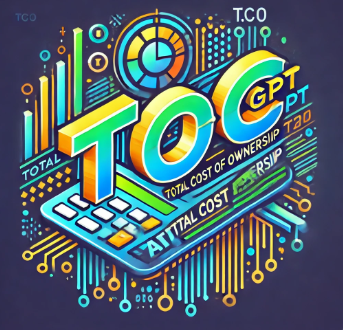What if the biggest threat to your bottom line isn’t a competitor—but the hidden costs quietly eating away at your profitability?
Too many businesses make high-stakes decisions based on purchase price alone, only to find themselves drowning in unexpected expenses down the road. Maintenance, compliance, downtime, disposal—it all adds up. That’s why forward-thinking businesses are turning to Revenue Model GPT to not only design smarter revenue strategies but to master Total Cost of Ownership (TCO) analysis—giving them the full financial picture before they make a move.
Whether you’re investing in new technology, expanding your fleet, or evaluating a major project, Revenue Model GPT helps you see beyond the price tag and into the true lifetime cost—so you can make decisions that protect both your cash flow and your long-term profitability.
Here’s how Revenue Model GPT transforms your financial planning with clear, data-driven, and strategic TCO analysis tailored to your business.
Comprehensive TCO Analysis—See the Full Picture, Not Just the Price
Most businesses budget for purchase price, but that’s only the tip of the iceberg. Revenue Model GPT breaks down your total cost across the entire asset lifecycle—from acquisition to disposal.
- Track all costs, including hidden expenses like regulatory fees, training, and cybersecurity compliance.
- Customize cost models to fit your industry, asset type, and financial goals, whether you’re in IT, manufacturing, logistics, or professional services.
- Build complete cost transparency, so you avoid surprises and plan your capital and operational budgets with confidence.
Cost Component Breakdown—Every Dollar Accounted For
Revenue Model GPT categorizes every cost into clear buckets, so you know exactly where your money is going:
- Acquisition Costs: Purchase price, shipping, taxes, installation.
- Operational Costs: Energy, labor, consumables, licenses.
- Maintenance Costs: Repairs, warranties, upgrades.
- Compliance Costs: Audits, regulatory filings, data privacy mandates.
- End-of-Life Costs: Decommissioning, resale, or disposal.
With this level of granularity, you’ll build financial plans rooted in reality, not assumptions.
Risk & Uncertainty Modeling—Prepare for What’s Next
Markets change. Regulations shift. Supply chains break. Revenue Model GPT doesn’t just calculate costs—it models the risks and uncertainties that could inflate those costs over time.
- See how inflation, regulatory changes, or technology obsolescence could impact total cost.
- Build risk-adjusted forecasts to protect profitability even in volatile conditions.
- Create contingency plans and cost buffers that keep your business resilient when the unexpected happens.
Side-by-Side Comparisons—Make Smarter, Data-Driven Decisions
Which option offers the lowest lifetime cost and the best long-term value? Revenue Model GPT compares multiple assets, vendors, or investment options side by side, highlighting:
- Short-term vs. long-term costs.
- Cash flow impact across different financing or ownership models.
- Risk exposure and potential cost overruns.
- ROI (Return on Investment) and NPV (Net Present Value) calculations that show which option drives better financial performance.
Tailored for Your Industry—Because One-Size Never Fits All
TCO analysis looks very different for a SaaS company migrating to the cloud than it does for a manufacturer upgrading production equipment. Revenue Model GPT tailors its analysis to fit your industry, business size, and financial goals:
- IT: Cloud vs. on-premises infrastructure.
- Manufacturing: Buy vs. lease equipment decisions.
- Logistics: Vehicle lifecycle cost and fleet management.
- Professional Services: In-house staffing vs. outsourcing.
Tax, Legal & Compliance Insights—Don’t Miss the Hidden Costs
Taxes, import duties, regulatory fees—they all sneak into your total cost and can erode your margins if you don’t plan for them. Revenue Model GPT factors in:
- Tax impacts (VAT, depreciation schedules, tax credits).
- Industry-specific regulatory compliance costs.
- Legal considerations tied to asset ownership, leasing, and end-of-life disposal.
Cost Reduction Strategies—Because Cost Awareness Isn’t Enough
Knowing your total cost is just the first step. Revenue Model GPT also recommends practical ways to reduce those costs without compromising performance or compliance.
- Preventive maintenance programs that extend asset life.
- Smarter vendor contracts and bulk purchasing discounts.
- Supply chain optimization and energy efficiency initiatives.
- Asset lifecycle extension strategies that reduce total capital spend.
The End Result—Profitable Decisions Backed by Complete Data
With Revenue Model GPT, you get:
- Complete cost transparency—no surprises, just data you can trust.
- Smarter decision-making—compare options, reduce risk, and maximize ROI.
- Confidence when presenting to investors, boards, or lenders—because every financial projection is rooted in a real-world understanding of lifetime costs.
Whether you’re evaluating a new investment, preparing for fundraising, or fine-tuning your business strategy, Revenue Model GPT helps you control costs, reduce risk, and drive profitability—all through smarter Total Cost of Ownership analysis.
Ready to understand the true cost of your next big decision? Let’s talk. Visit AIziip.com to see how Revenue Model GPT can give your business a financial edge with AI-powered analysis and strategy.
When you see the full cost picture, you make better decisions—and better decisions lead to stronger, more profitable businesses. Let’s make your next move the right one.

